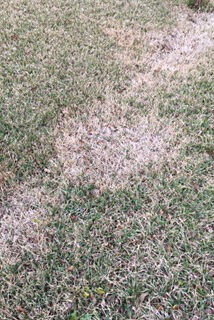Sperry: Not much can prevent cabbage loopers, but fast treatment helps
Published 5:30 pm Sunday, March 9, 2025

- Brown patch is affecting this St. Augustine lawn. (Contributed Photo)
Dear Neil: We started to notice these spots in the St. Augustine in late summer and they are still here. They began as yellowed grass. Many started out round. There is a slight dip along the line of the spots. The fence was installed about two months before the problem began. Our nursery gave me a couple of fungus products in October. I was told to treat again recently.
Your lawn has brown patch, also called large patch by some university turf people. It affects only the leaf blades where they attach to the runners. You will first notice that they turn yellow, then brown a few days later. You normally won’t see it until the first cool, wet weather of early fall (as you described). If you pull on those first yellowed blades you’ll find that they will pull loose quite easily from the runners so that you can see the decay caused by the fungus. If you treat at those first signs you can stop the disease before it gets to this point. The good news is that it won’t kill the grass. It does weaken it, but the roots and runners remain healthy. As your lawn greens up again this spring it will recover to grow through this problem. However, the brown patch will return, so be prepared to treat again this fall. Treating now will also be beneficial. The fungicide Azoxystrobin is often recommended for the patch diseases in turf.
Dear Neil: Attached is a photo of one of the larger branches we cut off one of our madrone trees. A local gardener said it was due to carpenter ants. We have been in a severe drought. The first tree started sending good shoots out from the bottom, with the top badly damaged, so we cut that part off. We thought that would stop it. Now the second tree is also dying with the branches turning black. Should we be watering more? They told us the ants would be seeking the water.
No photo was attached to your email, nor can I tell where you live and garden. Therefore, I’ll have to write rather generically.
Carpenter ants are opportunists. They live in decaying, hollowed out parts of trees, for example where limbs have died, woodpecker holes, cracks from storm damage, etc. They do not feed on the tree’s living wood. I guess you could call them secondary invaders. They do not kill trees.
If the drought has been really severe, you can certainly water your madrones. Make sure the drainage is good and check the trunks closely for any signs of damage. Perhaps you can see what might have happened. Depending on where you are, winter cold could also damage them. While they’ve native to southwestern parts of the state, that doesn’t guarantee that they’ll survive in colder regions. I had a friend years ago who lost several in the Dallas area so he switched over to growing one or two in large patio pots.
Dear Neil: Is there anything I can put on my cabbage plants as a preventive to avoid cabbage loopers this spring?
Not that I know of. Watch for the little white butterflies that will be circling around your plants in numbers in a few weeks. They’ll be laying the eggs that will hatch and develop into the hungry loopers. As soon as you see the first holes in the leaves, apply Bacillus thuringiensis as the biological worm spray or dust. It’s totally organic and it also happens to be the most effective control. The loopers will stop feeding within a couple of hours. You can eat produce that has been protected as soon as the same or next day. Just wash it to clean it up and you’ll be fine. You’ll want to keep an eye on other Cole crops as well: broccoli, Brussels sprouts, cauliflower, and even rutabagas.
Dear Neil: I have a rubber plant that has gotten very lanky and that now leans toward our patio door. Can I repot it and stake it? Can it be pruned to make it branch? If so, how and when?
I need to begin my answer by telling you that if you lived in a frost-free part of the world, you could plant it outdoors and watch it grow to be 45 or 50 ft. tall and wide. They are massive trees.
Yes, it can be pruned. I normally would suggest cutting it back to 10 or 15 inches (even if it meant that it had no leaves left) and repotting it one pot size larger. Get it out onto a shaded patio or beneath a large tree – someplace where it gets brighter light than it had inside your house, but no direct sunlight after 8:30 or 9 in the morning in summer. Apply a water-soluble, high-nitrogen plant food to encourage vigorous new growth and it will send out several new trunks. Let them develop for the first season, pruning off only those that cause it to be misshapen. It will be shrubby but beautiful.
You biggest problem will come when late fall arrives and you have to bring it back indoors. It became lanky because of insufficient light. You’ll want to cut back on the water and especially the fertilizer you give it over the winter. Rotate it every couple of weeks so the opposite side faces the window. That should help. Your goal will be to keep it static over the winter so that it doesn’t become leggy, but to give it enough light that it doesn’t drop its lower leaves.







